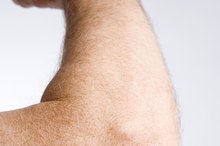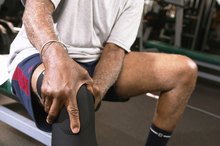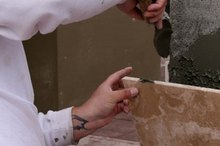A Fluid-Filled Sac on the Front of the Knee
The knees are subject to many types of mechanical and physical stress, which makes them vulnerable to several conditions. Four fluid-filled sacs called bursae occupy various sites at the front of the knee. These small sacs cushion knee bones and tendons, and reduce friction in the joint. Inflammation of a bursa, or bursitis, causes increased fluid production within the sac.
If you are experiencing serious medical symptoms, seek emergency treatment immediately.
This leads to swelling, pain and other knee symptoms. Bursitis can be triggered by different causes.
Frontal Knee Bursae
Some bursa at the front of the knee are commonly affected by bursitis while others are less frequently involved.
The most commonly affected bursa is the prepatellar bursa, located over the front of the kneecap beneath the skin. The infrapatellar bursae are the second most common knee bursae affected by bursitis 2. These bursae are located just below the kneecap over the knob-like bony prominence of the large lower leg bone. **There are superficial and deep infrapatellar bursae.
The suprapatellar bursa, located above the kneecap, less commonly develops bursitis. The pes anserine bursa can also be affected by bursitis, although this sac is located more to the inside of the knee rather than directly in front of the joint. **
- Some bursa at the front of the knee are commonly affected by bursitis while others are less frequently involved.
- The most commonly affected bursa is the prepatellar bursa, located over the front of the kneecap beneath the skin.
Role of Physical Knee Stress
What Causes Fluid on Your Knee?
Learn More
Knee bursae normally contain only a small amount of fluid.
Physical stress or trauma, however, can inflame a bursa and stimulate increased fluid production with accompanying swelling and discomfort.
Prolonged pressure through kneeling is a common cause of gradual fluid accumulation and the development of bursitis.
Acute knee trauma -- typically involving a forward fall onto the knees or a high-force blow to the front of the knee -- can trigger acute bursitis. These injuries commonly occur among wrestlers, and football and basketball players.
- Knee bursae normally contain only a small amount of fluid.
- Prolonged pressure through kneeling is a common cause of gradual fluid accumulation and the development of bursitis.
Other Causes of Bursitis
Certain diseases and conditions can also lead to knee bursitis. Arthritic diseases affecting the knee -- including rheumatoid arthritis, gout and pseudogout -- can trigger knee bursitis due to inflammation of the joint.
Knee bursae can also sometimes become infected, a condition known as infectious bursitis. This condition most often develops when there's been a skin-penetrating injury to the knee area. Children with an inflamed knee bursa are more likely to have infectious bursitis than adults are.
- Certain diseases and conditions can also lead to knee bursitis.
- Arthritic diseases affecting the knee -- including rheumatoid arthritis, gout and pseudogout -- can trigger knee bursitis due to inflammation of the joint.
Signs and Symptoms
Causes of Pain in the Upper Left Hip
Learn More
A history of frequent kneeling, or a recent fall or blow to the knee is often the first clue to possible bursitis. Common signs and symptoms of knee bursitis help in making the diagnosis. These include: -- knee swelling, tenderness, warmth and redness -- pain when walking -- intense pain with kneeling -- decreased knee mobility -- reduced pain with rest and at night -- fever, if the bursa is infected
Other Considerations
Knee swelling due to excess fluid in a knee bursa must be distinguished from fluid accumulation in the knee joint itself and soft tissue conditions that can trigger knee swelling. Therefore, a doctor needs to consider other possible causes of knee swelling, such as: -- knee tendinitis -- knee ligament or cartilage injury -- tumors or cysts involving the knee
A physical examination of the knee, laboratory testing and imaging studies -- such as x-rays or an MRI -- can help determine the accurate diagnosis.
Bursitis Treatment and Prevention
The initial treatment for bursitis involves avoiding activity that aggravates the knee. Injection of a corticosteroid may also be used to treat bursitis. If bursa fluid is infected, the bursa is opened, and antibiotics are started. When bursitis is chronic or recurrent, the bursa may need to be surgically removed.
Bursitis is less likely to develop when frequent breaks are taken from repetitive kneeling. Kneepads or compressive knee sleeves are often recommended, as are ice and elevation after working or playing sports. Physical therapy may decrease the chance of bursitis recurring.
Reviewed by: Tina M. St. John, M.D.
- The initial treatment for bursitis involves avoiding activity that aggravates the knee.
- When bursitis is chronic or recurrent, the bursa may need to be surgically removed.
Related Articles
References
- Insights Into Imaging: MRI Characteristics of Cysts and "Cyst-Like" Lesions in and Around the Knee -- What the Radiologist Needs to Know
- Wheeless’ Textbook of Orthopaedics: Bursae and Bursitis of the Knee
- International Journal of Rheumatology: MR Imaging of Intra- and Periarticular Cyst-Like Lesions of the Knee Joint in Workers with Occupational Kneeling
- American Family Physician: Evaluation of Patients Presenting with Knee Pain: Part II. Differential Diagnosis
- American Family Physician: Acute Knee Effusions: A Systematic Approach to Diagnosis
- Family Practice Notebook: Knee Effusion Causes
- Aaron DL, et al. "Four Common Types of Bursitis: Diagnosis and Management" J Am Acad Orthop Surg June 2011 ; 19:359-367.
Writer Bio
Jennifer Williams has been writing as a freelancer for local newspapers since 1999. Her work now appears on various websites. She did a five-year orthopaedic surgery residency, followed by a one-year sports medicine fellowship and has been a team physician for NCAA Division I universities and high school teams. As a former collegiate athlete, Williams continues competition at the masters level.






